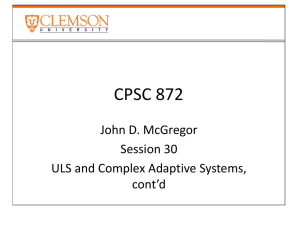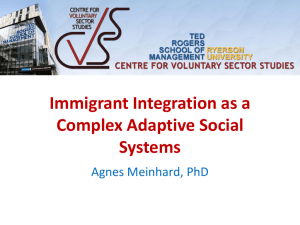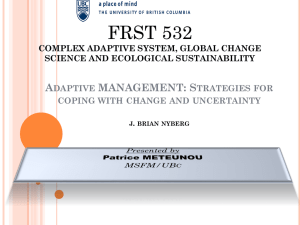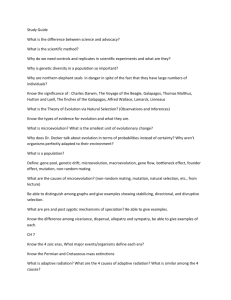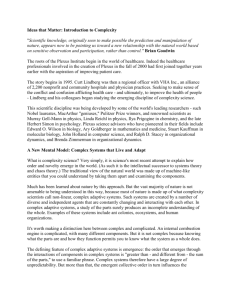Adaptive Complex Thinking
advertisement
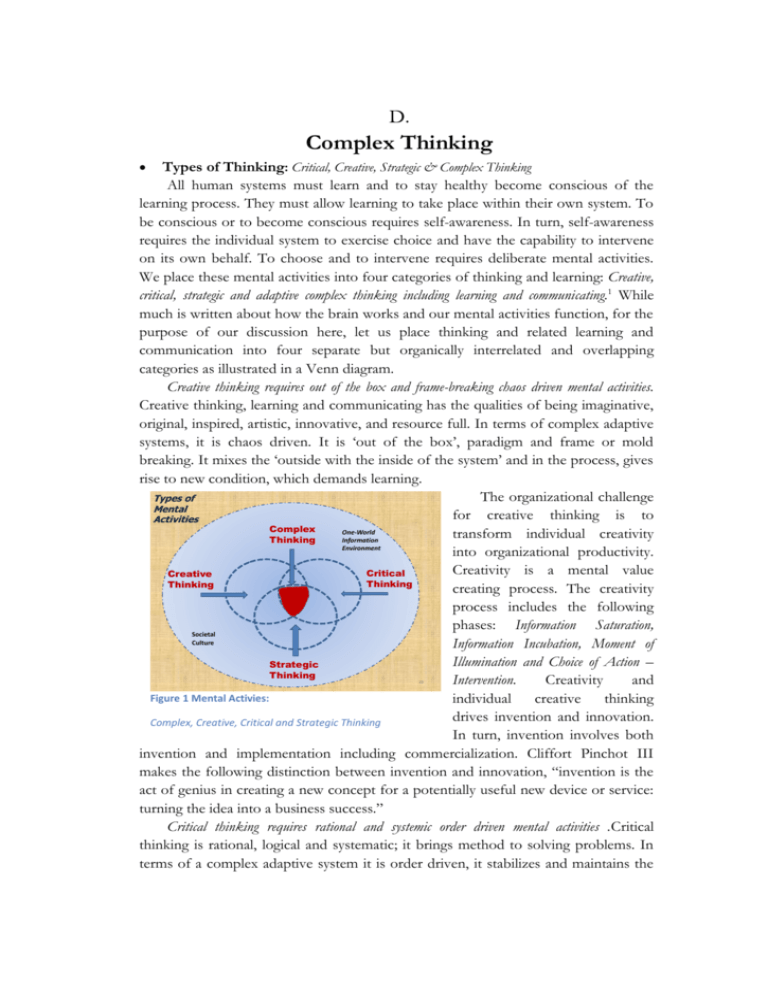
D. Complex Thinking Types of Thinking: Critical, Creative, Strategic & Complex Thinking All human systems must learn and to stay healthy become conscious of the learning process. They must allow learning to take place within their own system. To be conscious or to become conscious requires self-awareness. In turn, self-awareness requires the individual system to exercise choice and have the capability to intervene on its own behalf. To choose and to intervene requires deliberate mental activities. We place these mental activities into four categories of thinking and learning: Creative, critical, strategic and adaptive complex thinking including learning and communicating.1 While much is written about how the brain works and our mental activities function, for the purpose of our discussion here, let us place thinking and related learning and communication into four separate but organically interrelated and overlapping categories as illustrated in a Venn diagram. Creative thinking requires out of the box and frame-breaking chaos driven mental activities. Creative thinking, learning and communicating has the qualities of being imaginative, original, inspired, artistic, innovative, and resource full. In terms of complex adaptive systems, it is chaos driven. It is ‘out of the box’, paradigm and frame or mold breaking. It mixes the ‘outside with the inside of the system’ and in the process, gives rise to new condition, which demands learning. The organizational challenge Types of Mental for creative thinking is to Activities Complex One-World transform individual creativity Information Thinking Environment into organizational productivity. Creativity is a mental value Critical Creative Thinking Thinking creating process. The creativity process includes the following phases: Information Saturation, Societal Culture Information Incubation, Moment of Illumination and Choice of Action – Strategic Thinking Intervention. Creativity and Figure 1 Mental Activies: individual creative thinking drives invention and innovation. Complex, Creative, Critical and Strategic Thinking In turn, invention involves both invention and implementation including commercialization. Cliffort Pinchot III makes the following distinction between invention and innovation, “invention is the act of genius in creating a new concept for a potentially useful new device or service: turning the idea into a business success.” Critical thinking requires rational and systemic order driven mental activities .Critical thinking is rational, logical and systematic; it brings method to solving problems. In terms of a complex adaptive system it is order driven, it stabilizes and maintains the 38 SOLUTION LEADERSHIP system and provides rationale for the work that needs to be done. Critical thinking is at the core of traditional learning. Strategic thinking requires directional and goal oriented change driven mental activities. Strategic thinking is directional, purposeful and goal oriented. Strategic thinking combined with creative thinking can make the complex adaptive system visionary and future oriented. Combined with critical thinking, these forms of thought drive an organization’s strategic planning process. They demand a global perspective and require learning new competencies. (Strategic thinking is the key element in the Solution Execution Approach.) Complex thinking is grounded in the dynamics of complex adaptive systems and Adaptive Complex Enterprise behavior. The core of Complex Thinking is to understand the hidden order, dynamic patterns that its own system as well as others leaves behind. In terms of the complex adaptive system, it is attractor driven, the unfolding of the core organizing principle. Complex thinking drives the others three types of thinking but also in turn is the result. Adaptive complex thinking is critical to the system’ learning processes, it is essential to adaptation. Complex Thinking Processes Most individuals, to practice complex thinking will require a paradigm shifting mental exercise, a different view of the dynamics of the real world. Our overarching goal is to offer a guide to understanding the mental activities involved in complex thinking and application to real world problems demanding real world solutions. For leaders and professionals facing real time organizational problems, the real benefits of adaptive thinking is to identify and understand these problems, make appropriate and timely decisions and execute solutions in the context of the global information driven market. Adaptive complex thinking2 requires a different thought and reality paradigm. It is a mode of thinking, it is essential for human systems to survive, thrive and sustain growth and development in today’s turbulent information driven global environment. It allows local leaders to become comfortable with solving local problems in a global context and global problems in a local context. It is a challenge to explain the nature of Complex Thinking to the uninitiated because it involves the deliberate merging of commonly held intuitive and informal understanding of how things really work with the formal discipline of Complexity Science. The latter is an amalgam of existing scientific fields with a focus on complex dynamic and adaptive systems and their environments. The contribution of Complexity Science to understanding adaptive human behavior in turbulent environments is of particular importance to us because it provides the scientific underpinning for both the dynamics of Complex Adaptive Systems and Environment (CASE) and Complex Thinking MANFRED D. JANTZEN, PH.D. - 18 - SOLUTION LEADERSHIP What follows is a brief description of the key attributes of adaptive Complex Thinking. We will refer to Complex Thinking at times as Adaptive Thinking, depending on the application. Figure 2 Complex Thinking - Picture View Complex thinking is grounded in complex adaptive systems behavior and requires retraining and re-education and a new learning perspective. A key component of complex thinking rest on our traditional gut feeling, the inner voice and our intuition. In other words, we always had some rudementary and informal way of making sense of our changing surroundings. The challenge is to make these frequently hidden talents part of a formal approach in understanding a dynamic information rich world. 7 The mental activities of complex thinking include non-linear thinking, action learning, open-ended communication, and form-breaking creativity. Complex thinking requires a different mindset, a Global Mindset. Such a mindset is free to explore the human potential limited only by imagination in the new age of information and knowledge, which itself appears to have no boundaries. Adaptive complex thinking is grounded in understanding of the dynamics of Complex Adaptive Systems and their Environment (CASE) and the performance behavior of the Adaptive Complex Enterprise. The following summarizes the key characteristics of the adaptive complex thinking processes: Context, Integration, Creativity, Network, Probability, Process, and Emergence. MANFRED D. JANTZEN, PH.D. - 19 - SOLUTION LEADERSHIP Complex thinking is always contextual – system thinking, a shift from the parts to the whole.Adaptive complex thinking allows for the ability to shift one’s attention back and forth between system levels as well as between systems. Throughout the living world, we find system nesting within other systems and by applying the same concepts do different levels we can often gain important insights. Adaptive Complex Thinking – Key Attributes 1. 2. 3. 4. 5. 6. 7. 8. 9. 10. Is system thinking - Always in Context Is holistic thinking- Integrated Whole, not dissectible Is creative thinking – Different levels with different emergent properties Is network thinking - Relationships are primary Is process thinking - Feed back loops Activates the observer - Intervenes in reality Is open-ended - Allows an emergent future Engages the entire mind - including feelings It involves hindsight, foresight and insight Is based on Complex Adaptive System Behavior Figure 3 Complex Thinking: Key Attributes Yet we also recognize that different systems levels represent levels of different complexity. Complex thinking demands a holistic and integrated approach. Human systems, for that matter, all living systems are integrated wholes. Their properties cannot be reduced to those of smaller parts. Their essential or systemic properties are properties of the whole, which none of the parts have. In living system, they arise from the ‘organizing relations’ of the parts. Properties of living systems are destroyed when dissected into isolated elements. In complexity thinking, we know that any isolated element such as a body part of me can never reflect the essential Me as living human being. Furthermore, complexity thinking warns us that analysis alone will not lead us to deeper understanding of the system as a whole; in case of living system, the whole is greater than the sum of its (component) parts. Complex thinking is creative thinking. It accepts emergent properties within the same system and between systems. At each level the observed phenomena exhibits properties that do not exist at lower levels. The systemic properties of a particular level are ‘emergent’ properties, since they emerge at that particular level. Adaptive complex thinking recognizes different levels of complexity and emergent properties of systems. To put it in another way, interactions between different levels of the same system or different system unfold emerging properties that did not exist before. A dialogue or discussion between two or more people (systems) can develop brand new insights, ideas emerge that any one individual did not possess before. Complex thinking is network thinking. In adaptive complex thinking relationships are primary and objects secondary, a human system is a network of relationships. A MANFRED D. JANTZEN, PH.D. - 20 - SOLUTION LEADERSHIP complex adaptive system is a network of relations. Such network systems are everywhere. Complexity thinking is a shift from the objects to the relationships. Ultimately – as quantum physics shows so dramatically –there are no parts (objects) at all. What we call a part is merely a pattern in an inseparable web of relationships. In the mechanistic (old paradigm particle/matter world) view the world is a collection of objects, interacting with one another and hence there are relationships among them. However, the relationships are secondary. In the systems view we realize that the objects themselves are networks of relationships, embedded in larger networks.3 Complex thinking is always process thinking. Adaptive complex thinking requires an understanding of the nature of self-organization – pattern of ordered relationships. Self organizing systems deal with novelty, open system far from equilibrium, and non-linear interconnectedness of system components. It deals with feedback loops that simultaneously maintain and grow the system. Complex thinking intervenes in reality. We cannot observe reality without changing it. In adaptive complex thinking the scientific paradigm of scientific objectivity shifts to include the process of knowing. Unlike the assumption of the traditional scientific method, the human oberserver becomes a critical and an integral part of scientific theory. Adaptive complex thinking shifts from `scientific certainty’ to theories that are limited and approximate. Adaptive complex thinking operates in the realm of probability.4 Adaptive complex thinking allows the future to emerge, the future cannot be `intented’, it unfolds. The science of complexity demonstrates convincingly creative systems evolve into an open-ended evolutionary space so that the future is radically unpredictable. The long-term future of creative system is thus not simply currently unknown but completely unknowable. It will therefore be impossible to plan it or intend it in any way except through active participation. The future of an organization will emerge without prior intention, through spontaneous self-organization of the people who constitute it. Instead of planning their way into the future, they will create a future through double loop learning. Adaptive complex thinking allows the future to emerge, and for human systems to learn their way to the future. While the foregoing is true for a reality of complete turbulence, the actual world is much more mixed between total chaotic and orderly systems with most in state of perpetual change. Therefore, it is possible to ‘guide’ the system toward a preferred future by providing it with an overall direction. Such directional guidance is the ‘job’ of a solution leader. Solution Leaders and Decision-Making Solution Leaders create the future by giving directional guidance to the organization. In doing so they must have a global perspective and act as if all change is part of an interdependent One-World Information environment. They seek solutions in the context of global change, accepting that global and local change is MANFRED D. JANTZEN, PH.D. - 21 - SOLUTION LEADERSHIP interwoven, and they require a deep understanding of the web of life on this planet. According to the Heisenberg Principle,5 a principle from quantum physics, the observer changes the observation and the active involvement when observing a problem not only changes the problem but also to a large degree determines the solution. Consequently, leadership by altering perception not only shapes reality but also transforms perception into reality. Solution Leader C Problem – Solution Matrix Adaptive Complex Thinking Low Level New Problem New Solution Old •New Problem Solution Integrated One-World Environment A Problems Both old and new problems require new solutions in a One-World Environment New High Level New Old Problemsolving in a One-World Environment requires Adaptive Thinking Solution D Solution Old Old Old Problem Problem Insular Solutions Old B Manfred D. Jantzen, Ph.D. New 41 Figure 4 Problem-Solution Matrix: Decisions A major science driven paradigm shift has occurred, whose powerful nature is best understood on a global scale with anticipation of local changes. Any paradigm shifts can cause violent disruption in local human communities and in order to be deal with the emerging issues, solution leaders need to be capable of adaptive complex thinking. Complex thinking is grounded in the dynamics of complex adaptive systems and adaptive complex enterprise behaviour but also emerges out of the interaction of the other three types of thinking.6 Adaptive complex thinking is critical to the system’s learning processes and it is essential to adaptation. Adaptive complex thinking requires re-training and re-education and a new learning perspective. One key component rests on intuition and means that we always had some rudimentary and informal way of making sense of our changing surroundings. The challenge is to make these frequently hidden talents part of a formal approach in understanding a dynamic information rich world.7 MANFRED D. JANTZEN, PH.D. - 22 - SOLUTION LEADERSHIP For most individuals, in order to practice complex thinking will require a paradigm shifting mental exercise, a different view of the dynamics of the real world. The real benefit of adaptive thinking is to understand and identify problems, to make appropriate and timely decisions and execute solutions in the context of the global information driven market. The mental activities of complex thinking include non-linear thinking, action learning, open-ended communication, and form-breaking creativity. Complex thinking requires a different mindset, a global mindset, which is free to explore the human potential, limited only by imagination in the new age of information and knowledge, which itself appears to have no boundaries. Complex thinking is always contextual, it allows for the ability to shift one’s attention back and forth between system levels as well as between systems. Complex thinking demands a holistic and integrated approach and it is synonym to creative thinking. It accepts emergent properties within the same system and between systems. A dialogue or discussion between two or more people (systems) can develop brandnew insights and ideas will emerge in a way an individual alone would have not been capable of developing. Complex thinking is network thinking as a human system is a network of relationships; it is a shift from objects to relationships. In the systems view we realize that the objects themselves are networks of relationships, embedded in larger networks.8 Complex thinking is always process thinking, it requires an understanding of the nature of self-organization – pattern of ordered relationships. Self-organizing systems deal with novelty, open systems far from equilibrium, and non-linear interconnectedness of system components. It deals with feedback loops that simultaneously maintain and grow the system. Complex thinking also intervenes in reality. The scientific paradigm of scientific objectivity shifts to include the process of knowing. Unlike the assumption of the traditional scientific method, the human observer becomes a critical and an integral part of scientific theory. It shifts from ‘scientific certainty’ to theories that are limited and approximate. Adaptive complex thinking operates in the realm of probability.9 Adaptive complex thinking allows the future to emerge, as the future cannot be intended, it rather unfolds. The science of complexity demonstrates creative systems evolving into an open-ended evolutionary space so that the future is radically unpredictable. The long-term future of creative systems is thus not simply currently unknown but completely unknowable. It will therefore be impossible to plan the future, except through active participation. Tipping Point Decisions Adaptive complex thinking allows the future to emerge, and for human systems to learn their way to the future. Solution leaders must engage in action thinking to solve problems and create the future. The most critical aspect of leadership in today’s One-World, speed driven information environment is a leader’s decision-making MANFRED D. JANTZEN, PH.D. - 23 - SOLUTION LEADERSHIP capability. Through decision-making, which is the most information intensive process, a leader creates and maintains ‘power’ to influence actions. The most critical decision is a tipping point decision. In complexity science, a tipping point decision is where an existing system bifurcates, separating the old path and space from the new emerging path and space. Tipping point decisions create a new space and can only be made by a leader sensitive to the underlying bubbling or, in complexity science terms, perturbation of system energy released from tension from within a system, between the emerging new system and the existing old system. Tipping point decisions are not only information intensive but are extremely time sensitive – they must be made in the now space. In today’s world, a leader will be judged by the capability to make such tipping point decision; they cannot be delegated or even left to the most knowledgeable team. A leader’s first reaction to a tipping point bubbling-energy space is to fall back on survival traits. These typically take the form of delaying the decision in the hope that clarity will emerge with more information; deferring to others as a participatory team exercise and seeking advice; pretending there is no emergency or crisis and let others or events make the decision; and rationalizing it out of existence. A tipping point decision is frequently hidden in the chaotic and operational details overwhelming a leader’s concentration on what is emerging as a crisisthreatening event. Tipping points are real events that can and must be influenced by a leader’s judgment. No one else can do it, because the real power of a genuine leader is the capability to create the environment for the necessity of tipping point decisions to emerge in the first place. The very existence and actions of a strong leader is the creation of an information rich space, a new space where opportunity and risk demand tipping point decisions. Complex Thinking Assessment Use the following 10 characteristics to assess your comfort level and experience with the mental activities demanded by Complex Thinking. Are these characteristics part of your mental habit in understanding and finding solutions to real world challenges? Complex thinking requires an ‘open’ and learning state of mind and willingness to make decisions and take actions in high turbulent environment. How comfortable and experienced are you with each. Rate yourself on a scale from (1) one to (5) with (1) being very uncomfortable and/or lacking mental experience, (3) somewhat, (5) very comfortable and experienced in both decisionmaking and action-taking. MANFRED D. JANTZEN, PH.D. - 24 - SOLUTION LEADERSHIP 1. __/ Complex thinking is non-algorithmic. The path of action is not fully specified in advance, it is not quite logical, it is not quite predictable. How comfortable are you in proceeding with your decision and action? (Algorithm is a problem solving procedure proving a logical step-by-step procedure for solving a mathematical problem in a finite number of steps, often involving repetition of the same basic operation) 2. __/ Complex thinking is complex. The total path is not visible (mentally) from any single vantage point. There are many levels and multiple connections. 3. __/ Complex thinking yields multiple solutions. There is no single unique solution rather each solution has its own costs and benefits. 4. __/ Complex thinking involves subtle judgment and interpretation. It involves constant judging and interpreting, new information constantly emerges. 5. __/ Complex thinking involves multiple criteria. It involves application of multiple criteria that are sometimes in conflict with one another. 6. __/ Complex thinking involves uncertainty. Not everything (information) that bears on the task at hand is known. 7. __/ Complex thinking involves self-regulation. It cannot be imposed from without but must spring from within the individual. It is self-directed. 8. __/ Complex thinking involves bringing about meaning – order out of chaos. It creates or finds structure in apparent disorder –chaos, as the science of ‘hidden order’. 9. __/ Complex thinking is effortful. It involves considerable mental work in the kinds of elaboration (discussion, dialogue) and judgment required. 10. __/ Complex thinking reflects the activities of open living systems. It reflects relations and activities within a system (subsystems) and among living system which are interconnected, interrelated, interactive and integrated. MANFRED D. JANTZEN, PH.D. - 25 - SOLUTION LEADERSHIP Section I Frontier World Endnotes for Chapters 1 and 2 See Recommended Readings at the end of this CHAPTER. While Adaptive Complex Thinking is our formal designation for the mental activities required to understand Complex Adaptive Systems and their Environments, we will use at time both Adaptive Thinking and Complex Thinking interchangeably. 2 See Recommended Readings at the end of this CHAPTER. While Adaptive Complex Thinking is our formal designation for the mental activities required to understand Complex Adaptive Systems and their Environments, we will use at time both Adaptive Thinking and Complex Thinking interchangeably. 3Complexity thinking is in terms of network of relationships. This is a shift from the traditional architectural thinking -basic building blocks, foundations, fundamentals etc... The metaphor of knowledge as a building is being replaced by that of the network. System theory perceives reality as network of relationships, interconnected network of concepts and models in which there are no foundations in which no part is nay more fundamental than the other. Complexity thinking advocates a view of reality as an inseparable network of relationships. The material universe is seen as a dynamic web of interrelated events. None of the properties of any part of this web is fundamental; they all follow from the properties of the other parts, and the overall consistency of their interrelations determines the structure of the entire web. 1 4In the Cartesian paradigm, scientific descriptions are believed to be objective that is independent of the human observer and the process of knowing. The new paradigm implies that epistemology understanding of the process of knowing - has to be included explicitly in the description of natural phenomena. This recognition entered into science with W. Heisenberg and is closely related to the view of physical reality as a web of relationships. "What we observe is not nature itself, but nature exposed to our method of questioning". See: Heisenberg Principle in appendix Ralph D. Stacey, Strategic Management & Organizational Dynamics. (London: Pitman Publishing, Second Edition 1996) This work is still the best that this author has found that explains and applies in a clear manner the difficult concepts of complex system behaviour. Margaret J. Wheatley, Leadership and the New Science, Discovering Order in a Chaotic World, San Francisco; Barrett-Koehler 1992. Applications for Management Theory; Margaret Wheatley’s Leadership and the New Explored Organizational Behaviour from the Point of View of Chaos; Senge, Peter M. The Fifth Discipline: The Art and Practice of the Learning Organization (Paperback) N.Y. Doubleday. 2006 7 Alan Greenspan, the former chair of the Federal Reserve Board, USA in the introduction to his book, The Age of Turbulence, Adventures in a New World. (New York: Penguin Press, 2007) p.18. summarizes the challenges that individuals and societies are facing 8 Complexity thinking is in terms of network of relationships. This is a shift from the traditional architectural thinking – basic building blocks, foundations, fundamentals etc...The metaphor of knowledge as a building is being replaced by that of the network. System theory perceives reality as network of relationships, interconnected network of concepts and models in which there are no foundations in which one part is any more fundamental than the other. Complexity thinking advocates a view of reality as an inseparable network of relationships. The material universe is seen as a dynamic web of interrelated events. None of the properties of any part of this web is fundamental; they all follow from the properties of the other parts, and the overall consistency of their interrelations determines the structure of the entire web. 9 In the Cartesian paradigm, scientific descriptions are believed to be objective; that is independent of the human observer and the process of knowing. * Sections of this chapter are contained in Chapter 1, Paradigm Power, One World Information Dynamics, in Winston Dookeran’s, Power, Politics & Performance, A Partnership Approach to Development, Ian Randle Publishers, Miami (2012). 5 6 MANFRED D. JANTZEN, PH.D. - 26 - SOLUTION LEADERSHIP 9John Brockman (2003) The New Humanists: Science at the Edge, Sterling Publishing. In this Guide, the Human Enterprise includes all human systems from Global civilization, Society, Community of Interests and Stakeholders, Institutions, Public and Private organization and even the individual is viewed as a human enterprise. 9 This idea has much in common with that of the forces of differentiation and decentralization on the one hand, and integration and centralization on the other, in both extremes is where they fail. 9Newtonian science was about simplicity, complexity science deals with order at the edge of chaos. Complex adaptive systems are special cases of complex systems. They are complex in that they are diverse and made up of multiple interconnected elements and adaptive in that they have the capacity to change and learn from experience. The term complex adaptive system (CAS) was coined at the interdisciplinary Santa Fe Institute (SFI), by John H. Holland, Murray Gell-Mann and others. See Recommended Reading and Appendix at end of this CHAPTER. 9 MANFRED D. JANTZEN, PH.D. - 27 -

